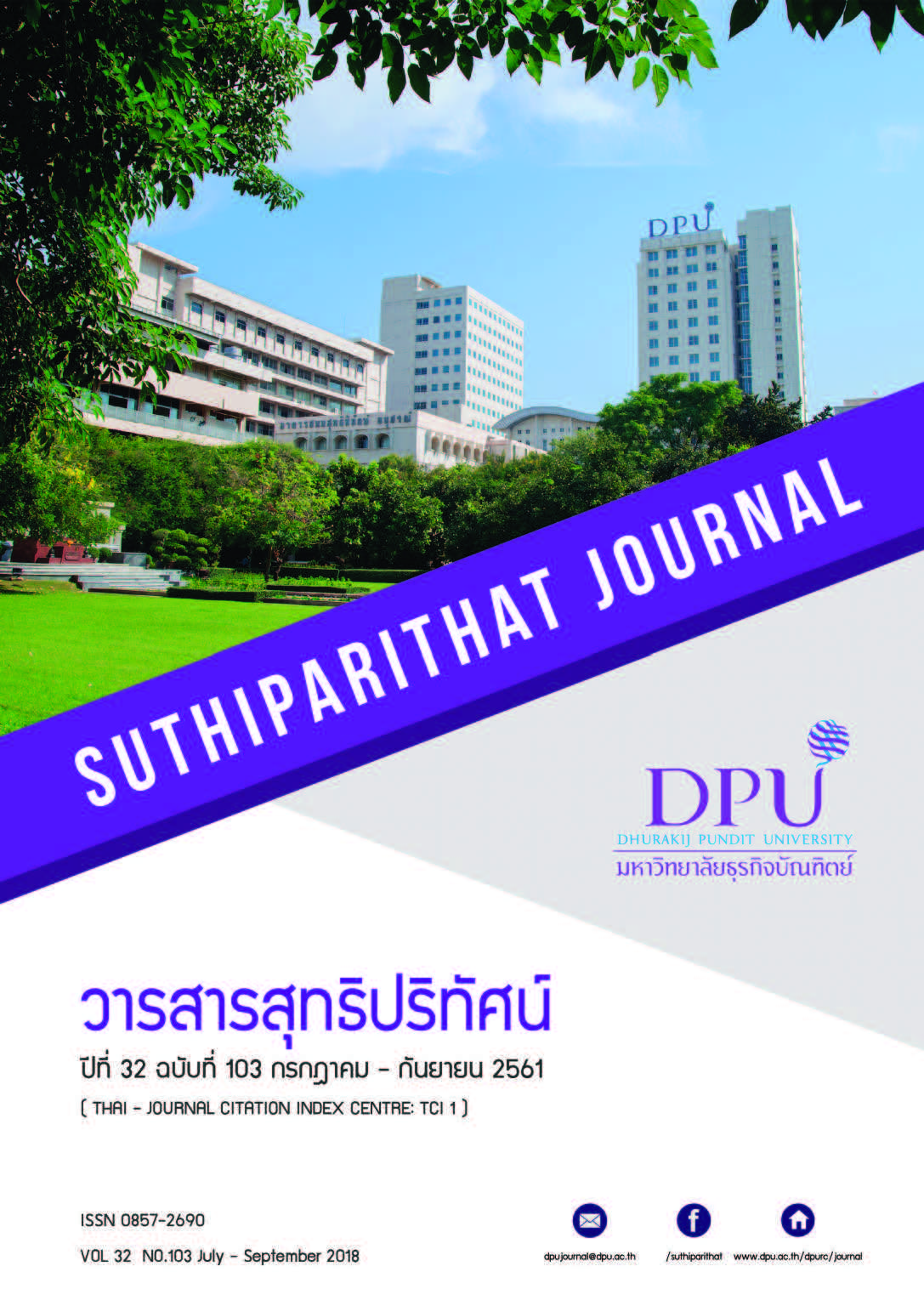องค์ประกอบการตรวจสอบระบบสารสนเทศที่เกี่ยวข้องกับการประเมินความเสี่ยงเทคโนโลยีสารสนเทศ
คำสำคัญ:
บริบทองค์การ, คุณลักษณะของระบบ, ผู้ตรวจสอบระบบสารสนเทศ, การประเมินความเสี่ยงเทคโนโลยีสารสนเทศบทคัดย่อ
ปัจจุบันองค์การธุรกิจได้ปรับเปลี่ยนกระบวนการสร้างความได้เปรียบทางการแข่งขันจากเดิม โดยการประมวลผลข้อมูลและการรายงานข้อมูลผ่านสื่อสิ่งพิมพ์มาเป็นการสร้างความได้เปรียบทางการแข่งขันสมัยใหม่โดยการผลิตเนื้อหาผ่านทางดิจิทัล ยิ่งไปกว่านั้น องค์การได้นำเทคโนโลยีสมัยใหม่ เช่น เทคโนโลยีความจริงเสมือน (Virtual Reality) มาสร้างมูลค่าให้แก่องค์การและความได้เปรียบทางการแข่งขัน และเพื่อช่วยเสริมศักยภาพการนำเสนอข้อมูลขององค์การธุรกิจ จากที่กล่าวข้างต้นอาจจะกล่าวได้ว่าข้อมูล และสารสนเทศของธุรกิจที่ถูกนำมาใช้ผ่านสังคมดิจิทัล (Digital Society) และเปิดเผยข้อมูลต่อสาธารณชน จากสถานการณ์ดังกล่าวผลกระทบเชิงลบหรือความเสี่ยงอาจจะเกิดขึ้นจากการใช้เทคโนโลยีสารสนเทศ ดังนั้น องค์การควรให้ความสำคัญกับองค์ประกอบการตรวจสอบระบบสารสนเทศที่ประกอบด้วยบุคลากร ด้านการตรวจสอบระบบสารสนเทศ คุณสมบัติของผู้ตรวจสอบระบบสารสนเทศภายในองค์การ และ บริบทองค์การที่เกี่ยวเนื่องกับกระบวนการการประเมินความเสี่ยงผ่านผู้ตรวจสอบระบบสารสนเทศ ซึ่งองค์ประกอบเหล่านี้จะช่วยให้ประกันได้ว่าการประเมินความเสี่ยงจากผู้ตรวจสอบระบบสารสนเทศนั้นมีความถูกต้องและแม่นยำตลอดจนสามารถลดความเสี่ยงทางเทคโนโลยีได้
เอกสารอ้างอิง
กรมพัฒนาธุรกิจการค้า. (2558). ระบบคุณภาพสำนักงานบัญชี. สืบค้นวันที่ 4 ธันวาคม 2560, จาก http://www.dbd.go.th/download/PDF_law/2.pdf
Allinson, C. (2004). The process of audit and control - a comparison of manual and electronic information systems Policing: An International Journal of Police Strategies & Management, 27(2), 183-205.
Burdea, C.G. and Coiffet, P. (2003). Virtual Reality Technology. (2nd edition). Hoboken, New Jersey: John Viley & Son.
D’Onza, G., Lamboglia, R., and Verona, R. (2015). Do IT audits satisfy senior manager expectations? A qualitative study based on Italian banks. Managerial Auditing Journal, 30(4/5), 413-434.
Maheshwari, A. (2017). Big Data. McGraw Hill Education.
Fenz, S., Heurix, J., Neubauer, T., and Pechstein, F. (2014). Current challenges in information security risk management. Information Management & Computer Security, 22(5), 410-430.
Filho, E.L., Hashimoto, G.T., Pedro, F., Souza, J.H.P., and De and Paulo, S. (2011). The impact of corporate culture in security policies – a methodology. The Seventh International Conference on Networking and Service (ICNS 2011), Venice. (PP: 98-103).
Hermanson D.R, Hill, M., and Ivancevich, D.M. (2000). Information technology related activities of internal auditor, Journal of Information Systems, 14(1), 39-53.
Hermanson, D.R., and Rittenberg, L.E., (2003). Internal audit and organizational governance. Research Opportunities in Internal Auditing, The Institute of Internal Auditors Research Foundation, Altamonte Springs, FL.
IBM Knowledge Center. (2013). CICS Transaction Server for z/OS, Version 3.2. Retrieved December 4, 2017, from https://www.ibm.com/support/knowledgecenter/SSGMGV_3.2.0/com.ibm.cics. ts.productoverview.doc/concepts/TransactionProcessing.html?view=embed
Information System Audit and Control Association. (ISACA). (2016). Information Systems Auditing: Tools and Techniques, Creating Audit Programs, ISACA. Retrieved December 4, 2017, from https://www.isaca.org/COBIT/Documents/IS-auditing-creating-audit-programs_whp_eng_0316.pdf
Mahzan, N., and Veerankutty, F. (2011). IT auditing activities of public sector auditors in Malaysia. African Journal of Business Management, 5(5), 1551-1563.
Moghaddasi, H., Sajjadi, S., and Kamkarhaghighi, M. (2016). Reasons in Support of Data Security and Data Security Management as Two Independent Concepts: A New Model. The Open Medical Informatics Journal, 10, 4-10.
Kanellou, A., and Spathis, C. (2011), Auditing in enterprise system environment: A synthesis, Journal of Enterprise Information Management, 24(6), 494-519.
Nuijtena, A., Keil, M., Pijla., G.V.D., and Commandeur, H. (2018). IT managers’ vs. IT auditors’perceptions of risks: An actor–observer asymmetry perspective. Information & Management, 55, 80-93.
Omoteso, K. (2013). Audit Effectiveness: Meeting the IT Challenge. New York: Routledge Taylor and Francis Group.
Palermo, T. (2011). Integrating risk and performance in management reporting: Research executive summary series. Chartered Institute of Management Accountant (CIMA), 7(5), 1-12.
Rhee, H.S., Ryu, Y.U. and Kim, C.T. (2012). Unrealistic optimism on information security management. Computers & Security, 31(2), 221-232.
Ridgeway, G. (2018). Policing in the Era of Big Data. Annual Review of Criminology, 1, 401-419. Retrieved December 4, 2017, from https://doi.org/10.1146/annurev-criminol062217-114209
Shahabuddin, A.M., Alam, A., and Azad, M. M. (2011). Internal Controls in Management Information System. International Journal of Computer Information Systems, 2(6), 58-78.
Shaikh, J.M. (2005). E-commerce impact: emerging technology – electronic auditing. Managerial Auditing Journal, 20(4), 408-421.
Shamala, P., Ahmad R., Zolait, A. H., and Sahib S. B. (2015). Collective information structure model for Information Security Risk Assessment (ISRA). Journal of Systems and Information Technology, 17(2), 193-219.
Dickmann, M., and Tyson, S. (2005). Outsourcing payroll: Beyond transaction-cost economics. Personnel Review, 34(4), 451-467.
Vasarhelyi, A. M., and Romero, S. (2014). Technology in audit engagements: A case study. Managerial Auditing Journal, 29(4), 350-365.
Vasarhelyi, M., Lombardi, D., and Bloch, R. (2010). The Future of Audit: A Modified Delphi Approach. SSRN Electronic Journal. 10.2139/ssrn.2488730.
ดาวน์โหลด
เผยแพร่แล้ว
รูปแบบการอ้างอิง
ฉบับ
ประเภทบทความ
สัญญาอนุญาต
เนื้อหาและข้อมูลในบทความที่ลงตีพิมพ์ในวารสารสุทธิปริทัศน์ ถือเป็นข้อคิดเห็นและความรับผิดชอบของผู้เขียนบทความโดยตรงซึ่งกองบรรณาธิการวารสาร ไม่จำเป็นต้องเห็นด้วย หรือร่วมรับผิดชอบใด ๆ
บทความ ข้อมูล เนื้อหา รูปภาพ ฯลฯ ที่ได้รับการตีพิมพ์ในวารสารสุทธิปริทัศน์ ถือเป็นลิขสิทธิ์ของวารสารสุทธิปริทัศน์หากบุคคลหรือหน่วยงานใดต้องการนำทั้งหมดหรือส่วนหนึ่งส่วนใดไปเผยแพร่ต่อหรือเพื่อกระทำการใด ๆ จะต้องได้รับอนุญาตเป็นลายลักษณ์อักษรจากวารสารสุทธิปริทัศน์ก่อนเท่านั้น







